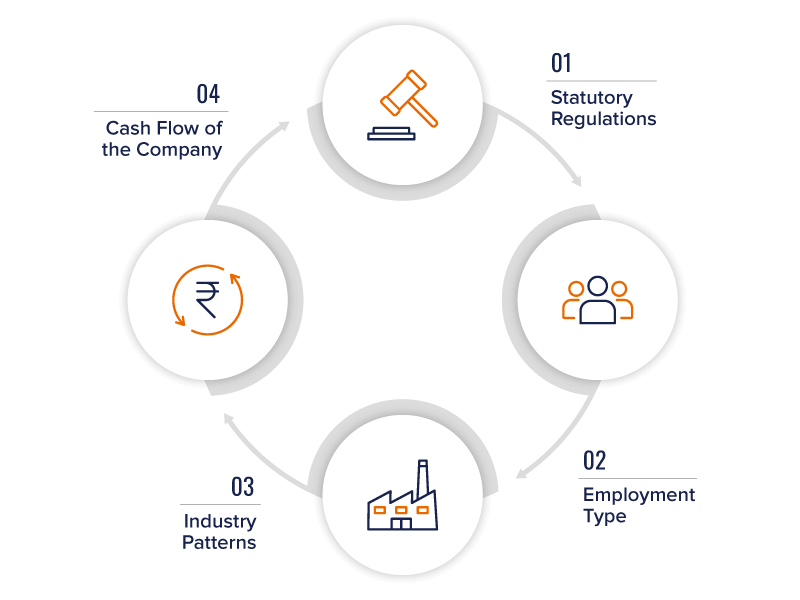Payroll Cycle: Definition, Types, And Factors To Consider While Choosing It

Table of Contents
What is the most important thing when it comes to managing your employees’ payroll? If you thought about the accuracy and statutory compliance of the payment to the employees, you are not wrong. However, there is one thing that we all neglect when we think about this question; and that is the payroll cycle. This is not a term that you frequently come across. This article talks about the meaning and types of the payroll cycle and the other factors that you need to consider while choosing it effectively.
What is a Payroll Cycle?
If you are using any kind of cloud-based payroll software then you might have heard that your software is supporting monthly or weekly payroll cycles, so let understand what does it mean. Generally, the cycle denotes the rate at which a particular thing takes place over a given period. You can call it recurrence or regularity. When combined, the term ‘pay’ cycle refers to the rate at which the employee’s salary is made over time. It can be called regularity of salary or recurrence of salary.
The most common query in the mind of the readers after understanding the payroll cycle is – Does it make a difference in the annual salary or tax liability? Companies can understand the employees’ curiosity to understand this concept. The payroll cycle does not change the employees’ payment amount – either positively or negatively. The employees’ annual income remains the same; so does their tax liability. The only thing that changes is the number of salaries that the employee receives in a year.
From the options of Daily, weekly, bi-weekly, semi-monthly, or monthly, the companies are free to choose a payroll cycle that they want to use. However, organizations need to keep in mind the basics of their payroll process to select a suitable payroll cycle. Besides that, the selection can depend upon various factors, which we will discuss later in the article.

Types of Payroll Cycle
As mentioned in the paragraph above, there are five types of an employee payroll cycle. The only difference among the five is the time between the two salaries. The following are the five classifications of the payroll cycle:
Daily
A daily employee payroll cycle refers to paying the employees daily. This payroll cycle is mostly used for the job profiles of construction workers, agriculture workers, carpenters, plumbers, electricians, etc. The daily payroll cycle ensures that the work assigned to workers is done by the end of the day in order for them to get paid. Whenever you get into any situation where your production requirements suddenly increase, and your existing employees aren’t able to complete it on time, you also can’t afford to hire any new permanent employee for that added work only. Then you can just find someone to assign them that work and pay them on a daily basis until the work is done.
One of the biggest advantages of the daily payroll cycle is the easiness and flexibility in hiring workers. As there are a high number of unemployed people in the market but not as many job opportunities, you can easily find the best-suited candidate for your work. And even if you don’t like his work, then you can just pay him for the day he worked and find someone else for the next day. One added advantage of the daily payroll cycle is that you don’t have to pay the workers for weekends and holidays, unlike in weekly, bi-weekly, and monthly payroll cycles.
Weekly
A weekly employee payroll cycle refers to paying the employees each week. The amount they receive is significantly less, and hence they need to be paid more frequently. The organization needs to run more frequent payroll cycles for such payments. An employee is paid 52 times a year. It is rarely used in any sector in India.
The weekly payroll cycle’s benefits are reaped by both – the employer and employees. The employees receive frequent and consistent paychecks. Given the expenses of the employees, they may face financial hardships if they are paid monthly. Weekly pay guarantees that the employees have enough hard cash to pay for their necessities. Moreover, if the employees have worked overtime, they don’t have to wait for the OT pay until the end of the month. They can cash in the fruits of their hard work by the end of the working week.
For employers, the weekly payroll cycle supports the business by making planning simple and straightforward. Monthly or semi-monthly payroll can be a hassle to manage. Instead of adjusting the payroll cycle on random days of the month, the weekly pay period allows you to have a fixed day every week in which you process payroll.

Bi-Weekly
When you pay your employees every other week, you pay them bi-weekly. In this method, the employee receives approximately 2 salaries a month, coming to 26 salaries a year. However, there can be about two months in a year where the payment can be made thrice a week. The education, health services, information, leisure, hospitality, and information industry are the ones that use a bi-weekly method of payment.
Bi-weekly payment allows the employees to meet their expenses on time due to the regularity of the payment. In addition, it will enable them to feel secure as they know that the paycheck will come on the same day every two weeks, meaning they do not have to worry that they will receive late or early paychecks.
The employer can save time and minimize the possibility of making a mistake in the entire payroll process as compared to the monthly pay period.
Semi-Monthly
Bi-weekly and semi-monthly payroll cycles can be easily muddled as both are paid twice a month. However, the distinction between the two is that the former payroll cycles is carried out on fixed days of the week, while the latter is paid on specific dates of the month. For example, in a bi-weekly pay, the organization pays the employees every second Saturday. While in the case of semi-monthly payment, the organization pays the employees on the 15th and 30th of every month. It is difficult to track as there are no fixed days on which these dates fall. The employees receive a total of 24 paychecks a year – precisely two paychecks a month.
This form of payment usually fits with the payroll management software and other pay structures, making it easy for the organization to meet the employees’ expectations effectively. It is often seen that the organizations that are exceptionally huge use this method of payment for the salaried staff. Besides, with semi-monthly pay period, the employer can maintain a steady cash flow for the organization as he has to have enough cash to meet the payroll needs twice every month. Furthermore, the employer’s challenges in calculating weekly pay for the leap years are reduced as the employees do not count the leap days in a year or month.

Monthly
Monthly payouts are one of the most commonly used modes among the various payment options for salaried employees. The salary paid through this type of payroll cycle is usually very high compared to the payments made through the weekly or bi-weekly methods. As the name suggests, the payment made to the employees is at the end of every month. The employer pays the employee a total of 12 paychecks a year under the monthly pay period.
The employees who plan their income and expenses and move in their lives accordingly are the ones who benefit from this method. A monthly salary allows them to have scope for little savings as well.
Employers do not have to bother going through the payroll process more than once a month. This saves them a lot of time and energy that can be used on more critical issues. In India, most companies use a monthly payroll cycle. The reason behind that is the statutory compliance of India that prefers the monthly payroll cycle.
How to choose a Payroll Cycle?
There are several factors to determine the selection of the suitable employee payroll cycle for the organization. Therefore, besides the provisions of the organization’s own HRM guide, they need to consider the following external factors:

Statutory Regulations
The statutory laws for payroll cycle vary from state to state. In many states, the law mentions the limit to minimum pay interval, which ensures that the organization’s payroll cycle does not conflict with the legal provisions. Other states have very particular conditions for the pay periods in that region. For example, the law may mandate a specific payroll cycle for the employee’s kind of work.
The organizations can pay the employees more frequently than the legal provisions state; however, they cannot pay them less than what is mentioned in the laws. The organizations are bound to be in legal trouble if they are caught trying to bring changes with the intention of escaping the payment of wages. Due to this, businesses and organizations need to make sure that they comply with the statutory regulations concerning the employee payroll cycle.
Employment Type
Not all employees can be grouped under one payroll cycle. Understanding the employment types helps determine the employee payroll cycle that will be covered. Usually, the employees who are unskilled and work at construction sites, as housemaids, or in similar fields are paid daily. Similarly, skilled employees under the salaried class are covered under the monthly payroll cycle.
Industry Patterns
What type of payroll cycles do the other organizations in the industry follow? It may assist you in knowing what methods and patterns would be easy to follow. After all, the entire industry cannot be wrong in following a particular manner, right?
Cash Flow of the Company
One of the most important factors you need to consider while selecting your payroll cycle is the cash flow of the company. If your company’s cash inflow determines how you should pay your employees, if you have cash inflow on a weekly basis, then you may select a daily or weekly payroll cycle. If your cash inflow is on a monthly basis, then you must select the monthly payroll cycle because you won’t have enough funds on weekly intervals to pay your employees on a weekly cycle.

Summing It Up
The payroll cycle in an organization can significantly impact various aspects, including employee motivation, overall productivity, and even the company’s market image. Therefore, choosing the right type of employee payroll cycle is crucial. Understanding your options and the factors to consider before selecting a suitable cycle is essential. Check out the best payroll software in India that can streamline the payroll process, regardless of the chosen cycle, freeing up your HR team’s time for more strategic initiatives.
Grow your business with factoHR today
Focus on the significant decision-making tasks, transfer all your common repetitive HR tasks to factoHR and see the things falling into their place.

© 2025 Copyright factoHR


